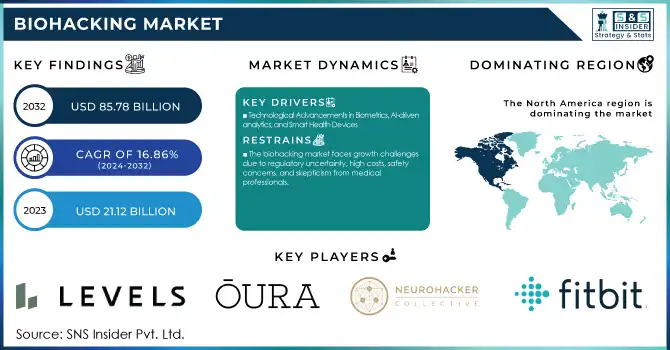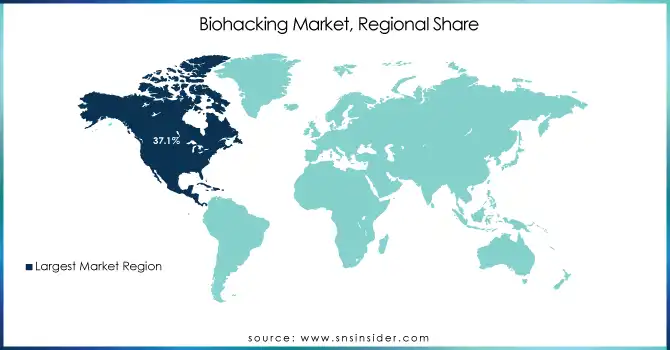Global Biohacking Market Size & Overview:
The Biohacking Market size was valued at USD 21.12 billion in 2023 and is expected to reach USD 85.78 billion by 2032 and grow at a CAGR of 16.86% over the forecast period of 2024-2032.

To Get More Information on Biohacking Market - Request Sample Report
The biohacking market is rapidly expanding due to the development of biotechnology, wearable health devices, nootropics, and genetic engineering. Biohacking has also become a related term for human augmentation. The activity involves self-experimentation techniques that contribute to cognitive function improvements, changes in physical performance, and longevity. The trend is being mainstreamed through increasing funding from tech entrepreneurs, venture capitalists, and healthcare innovators.
The growth in the rate of wearable technology and biometric tracking is one main stimulant for this market. Companies such as Apple, WHOOP, and Oura lead the sector by way of products measuring sleep, HRV, glucose levels, and stress markers. Industry reports expect the wearable health tech industry to grow over 20% year on year over the coming years, with such growth demonstrating great consumer interest in real-time health insights. Biohacking implants, including RFID chips and neural interfaces, are gaining popularity, while companies such as Neuralink and Kernel have been experimenting with brain-computer interfaces (BCIs) to upgrade cognitive abilities.
Other critical trends for the market include a rise in DIY biology and citizen science. Access to tools in genetic engineering such as CRISPR enabled the biohackers to perform experiments on gene modification, personalized medicine, and synthetic biology. Such rapid progress, however has resulted in intense debate on issues of regulation and ethics, mainly in terms of government efforts to innovate without threatening the biosecurity risk.
Another big segment is represented by Nootropics and bio-enhancing supplements within the biohacking market. With the increasing demand for cognitive enhancers, adaptogens, and anti-aging compounds, companies selling customizable supplement regimens have increased with time. According to a National Library of Medicine study, the nootropics market is likely to see double-digit growth because of the increasing consumer interest in memory enhancement and stress reduction. For instance, NAD+ supplements which only were applied for IV treatment recently became available in skincare and oral supplements such as from the brand Dr. Sam Bunting and Intuisse.
Despite its promise, the biohacking industry has regulatory and ethical issues. Authorities are watching closely the safety of unregulated supplements, gene-editing experiments, and extreme biohacking practices such as plasma transfusions and DIY hormone therapy. Notably, biohacker Bryan Johnson, who spends millions annually on anti-aging interventions, has brought attention to the sector's potential but also its controversies.
Moreover, the future of biohacking lies in AI-driven health optimization, microbiome research, longevity therapies, and brain augmentation. As scientific advancements continue, biohacking is transitioning from an underground movement to a mainstream health revolution, transforming the way people optimize their bodies and minds.
Biohacking Market Dynamics
Drivers
-
Rising Consumer Awareness and Demand for Personalized Health Solutions
With health concerns like chronic diseases, aging, and mental well-being - people need personalized solutions that can optimize health. Diet alteration, sleep monitoring, and various biofeedback strategies have become common biohacking techniques to perform better and increase longevity. A high demand in biohacking products and services has resulted from this trend in the form of advanced nutraceuticals up to customized wellness plans. Companies such as Viome offer microbiome-based personalized nutrition, while Levels provides real-time glucose monitoring to help users optimize their diets. The shift towards preventive healthcare and proactive well-being management further strengthens the market's growth trajectory.
-
Technological Advancements in Biometrics, AI-driven analytics, and Smart Health Devices
The integration of cutting-edge technologies has renovated the biohacking space into how people can monitor and optimize their biological functions. State-of-the-art innovations in continuous glucose monitoring, brainwave tracking, and real-time biomarker analysis allow users to gain insights into their health. Predictive analytics, which involves significant AI and machine learning contributions, can detect issues early on in a person's health and hence obtain personalized recommendations. Wearable health devices, neurostimulation gadgets, and implantable sensors have become increasingly complex, which can make biohacking easier to access and successful for more users. For instance, WHOOP and Oura have designed their wearables as advanced trackers that monitor sleep quality and recovery metrics, and Neuralink is focused on brain-computer interfaces, which are also expected to develop cognitive functions.
-
The growing availability of biotechnology tools and DIY biology kits has empowered individuals to take control of their health in unprecedented ways.
At-home genetic testing kits, microbiome sequencing, and bioengineering resources enable users to analyze and modify their biological data. Open-source movements and knowledge-sharing platforms foster collaboration among biohackers, researchers, and wellness enthusiasts. This trend supports the rise of citizen scientists experimenting with innovative interventions, from personalized medicine to gene editing. For instance, the CRISPR Do-it-yourself kits that enable personal genetic experiments, and biopunks like The Odin labs present training as well as equipment for exploring the world of biotechnology efficiently and safely. Further decreases in accessibility to biological technological advancements for both industries will lead to the expansion of the biohackers market into a new century of self-directed health optimization.
Restraints
-
The biohacking market faces growth challenges due to regulatory uncertainty, high costs, safety concerns, and skepticism from medical professionals.
Governments and health agencies find it challenging to issue clear guidelines for companies and individuals involved in biohacking. Moreover, expensive advanced biohacking technologies and treatments limit their accessibility, hence making cryotherapy, hyperbaric oxygen therapy, and brain-computer interfaces inaccessible to the average consumer. Moreover, safety concerns make a huge barricade. A variety of unplanned health risk issues or possible misuse of genetic technologies and threats to security will be involved because of uncontrolled biohacking experiments and other DIY biology experiments. Also, there is concern from the physicians due to scarcity of significant clinical studies which may further delay full-scale acceptance into the mainstream by medical professionals.
Biohacking Market Segmentation Analysis
By Product
The wearables segment emerged as the dominant category in the biohacking market with a 30.3% share in 2023, driven by the increasing demand for smart health monitoring devices. Wearable technology, including smartwatches, continuous glucose monitors, and biometric sensors, has been highly adopted by consumers who are keen on getting insights into their health in real-time. These gadgets allow users to monitor vital signs, optimize their fitness routines, and manage chronic conditions, hence becoming a central part of modern biohacking practices. Meanwhile, the mobile apps and pharmaceutical industry segments are expected to see the fastest growth throughout the forecast period. Advancements in artificial intelligence and personalized wellness programs fuel the rise in mobile health applications. It provides the ability for users to track their biometrics, monitor their nutrition, and get data-driven recommendations.
By Application
In 2023, the diagnosis and treatment segment dominated the biohacking market with a 34.1% share, primarily due to the increasing integration of biohacking techniques in healthcare. Rising interests in early detection of diseases, personalized medicine, and non-invasive treatments speed up the deployment of biohacking technologies into medical diagnostics. Wearable biosensors, lab-on-a-chip devices, and AI-enabled health assessment techniques have changed disease monitoring to include tracking biomarkers and potential risk factors for any health problem well before its establishment. Moreover, biohacking solutions are being integrated into precision medicine, so that a patient can be provided with targeted treatment considering his/her genetic type as well as metabolic profile. Chronic diseases are becoming common, and consumer awareness regarding health management has increased so this segment has been sped up. The expanding efforts of research and development are bound to take applications in diagnostics and treatment by biohacking towards transforming the old ways of health care and therefore improving patient outcomes and changing toward personalized data-driven medical interventions.
Biohacking Market Regional Insights
North America dominated the region of the market with a 37.1% share in 2023 due to its strong technological advancements, high consumer awareness, and well-established healthcare infrastructure. The United States, in particular, has been at the forefront of biohacking innovations, driven by the presence of major biotech companies, research institutions, and early adopters of self-optimization technologies. Additionally, the growing popularity of personalized health solutions, nootropics, and wearables has fueled market expansion in the region. Favorable regulatory frameworks, increasing investment in biotechnology, and a rising number of biohacking enthusiasts further contribute to North America’s leadership in the global market.
Europe closely followed with developments in precision medicine, higher genetic engineering research, and greater emphasis on longevity and wellness. The countries in this region such as Germany, UK, and Switzerland are more widely adopting the solutions of biohacking through wearables, supplements, and neuroenhancements. The government of the region is also investing in healthcare innovation and sustainable wellness solutions.
The Asia-Pacific region is projected to grow at the fastest pace in the overall forecast period due to the rise in investment in biotechnology, health awareness, and increased disposable incomes. The rapid adoption of biohacking techniques in China, Japan, and South Korea is mainly being used in smart healthcare applications and mobile health monitoring. Furthermore, increasing pharmaceutical and nutraceutical industries in the region drives the demand for biohacking supplements and smart drugs.

Do You Need any Customization Research on Biohacking Market - Enquire Now
Key Players and Their Biohacking Products
-
Apple Inc. – Apple Watch
-
Fitbit – Fitbit Charge Series
-
The Odin– DIY CRISPR Kits
-
Thync Global, Inc. – Thync Relax Pro
-
Neurohacker Collective – Qualia Mind
-
HVMN – Nootrobox & Ketone-IQ
-
Oura Health – Oura Ring
-
Biohacked – Biohacked Supplements
-
Dangerous Things – RFID & NFC Implants
-
WHOOP – WHOOP Strap
-
Eight Sleep – Pod 3 Mattress
-
ModafinilXL – Modafinil Smart Drug
-
Levels Health – Levels CGM (Continuous Glucose Monitor)
-
Halo Neuroscience – Halo Sport Headset
-
Bulletproof – Bulletproof Coffee & Supplements
Recent Developments & Trends
In Nov 2024, LeBron James reportedly invested USD 1.5 million annually in advanced biohacking techniques to maintain his fitness and extend his NBA dominance. His regimen included cryotherapy, hyperbaric oxygen therapy, and personalized nutrition, highlighting the growing adoption of biohacking in professional sports. This development underscored the increasing demand for cutting-edge wellness technologies in the market.
In July 2024, Kerala-based health-tech startup Vieroots launched India's first Biohack Centre in Kochi. This initiative marked a significant milestone in the country's wellness and longevity sector, offering advanced biohacking solutions focused on personalized health optimization and preventive healthcare.
| Report Attributes | Details |
|---|---|
| Market Size in 2023 | USD 21.12 Billion |
| Market Size by 2032 | USD 85.78 Billion |
| CAGR | CAGR of 16.86% From 2024 to 2032 |
| Base Year | 2023 |
| Forecast Period | 2024-2032 |
| Historical Data | 2020-2022 |
| Report Scope & Coverage | Market Size, Segments Analysis, Competitive Landscape, Regional Analysis, DROC & SWOT Analysis, Forecast Outlook |
| Key Segments | • By Product [Wearables (Wearable Neurotech, Oura Ring, Muse Headband, Others), Implants (Blood Test Implant, Circadia Implant, NFC and RFID Tags, Others), Gene Modification Kits, Smart Drugs, Supplements, Mobile Apps, Others] • By Application [Synthetic Biology, Genetic Engineering, Forensic Science, Diagnosis & Treatment, Drug Testing] • By End-use [Pharmaceutical & Biotechnology Companies, Hospitals & Clinics, Forensic Laboratories, Research & Academic Institutes] |
| Regional Analysis/Coverage | North America (US, Canada, Mexico), Europe (Eastern Europe [Poland, Romania, Hungary, Turkey, Rest of Eastern Europe] Western Europe] Germany, France, UK, Italy, Spain, Netherlands, Switzerland, Austria, Rest of Western Europe]), Asia Pacific (China, India, Japan, South Korea, Vietnam, Singapore, Australia, Rest of Asia Pacific), Middle East & Africa (Middle East [UAE, Egypt, Saudi Arabia, Qatar, Rest of Middle East], Africa [Nigeria, South Africa, Rest of Africa], Latin America (Brazil, Argentina, Colombia, Rest of Latin America) |
| Company Profiles | Apple Inc., Fitbit, The ODIN, Thync Global, Inc., Neurohacker Collective, HVMN, Oura Health, Biohacked, Dangerous Things, WHOOP, Eight Sleep, ModafinilXL, Levels Health, Halo Neuroscience, Bulletproof. |

